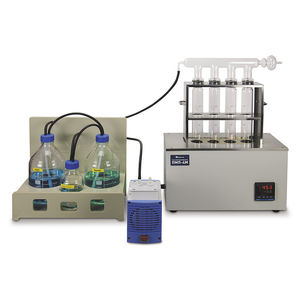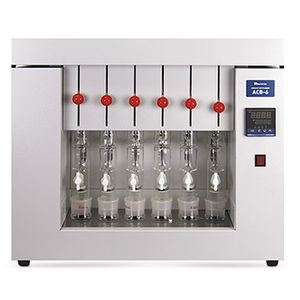
- Продукция
- Каталоги
Дистиллятор метод Кьельдаля AKV-10для лабораторийдля пищевых продуктов






Добавить в папку «Избранное»
Добавить к сравнению
Характеристики
- Место применения
- для лабораторий, для пищевых продуктов
- Другие характеристики
- метод Кьельдаля
Описание
Kjeldahl protein analyzer AKV-10It is primarily intended to replace glass instruments assembled by laboratory personnel independently. The simple design and operation, the minimum of electronics, but at the same time the convenience in operation and maintenance make this device an excellent choice for laboratories with a small amount of analysis, but who want to reduce the labor costs of assembly, disassembly, preparation for operation of well-assembled systems for ammonia stripping by the Kjeldahl method . The AKV-10 device is used to determine the mass fraction of protein in accordance with GOST in various food products and drinks, in particular, in cottage cheese, sour cream, milk, beer, cereals, canned meat, cereals, etc., animal feed and animal feed as well as nitrogen content in fertilizers and soil samples. In particular,
The Kjeldahl method for determining the mass fraction of protein in food products includes the following steps: mineralization (burning) of the analyzed sample of the food product with sulfuric acid, resulting in the formation of ammonium sulfate, then it is converted into ammonia, which is distilled off into boric acid solution with water vapor, titration of the resulting solution and calculation of the mass of protein in the test sample.
Brief technical characteristics of the Kjeldahl AKV-10 device:
• Power supply: 220 V, 50 Hz.
• Power Consumption: 1000 watts.
• Cooling water: 3 l / min, 20 ° C.
• Overall dimensions (LxWxH): 375 × 320 × 675 mm.
• Weight: 20 kg.
Другие изделия Vilitek LLC
Analyzers of protein, fat, fiber and moisture concentration
Расширенный поиск
- Анализатор для газов
- Дробилка
- Автоматизированный анализатор
- Анализатор для пыли
- Горизонтальная дробилка
- Анализатор для лабораторий
- Дробилка для отходов
- Анализатор для азота
- Дробилка для лабораторий
- Система очистки
- Дробилка с вращающимся барабаном
- Дробилка для измельчения сухим способом
- Шариковая дробилка
- Термостатическая баня с цифровым индикатором
- Экстрактор
- Автоматический дистиллятор
- Анализатор для протеинов
- Бардачок
- Дигестор
- Дистиллятор для лабораторий
* Цены указаны без учета налогов, без стоимости доставки, без учета таможенных пошлин и не включают в себя дополнительные расходы, связанные с установкой или вводом в эксплуатацию. Цены являются ориентировочными и могут меняться в зависимости от страны, цен на сырьевые товары и валютных курсов.











